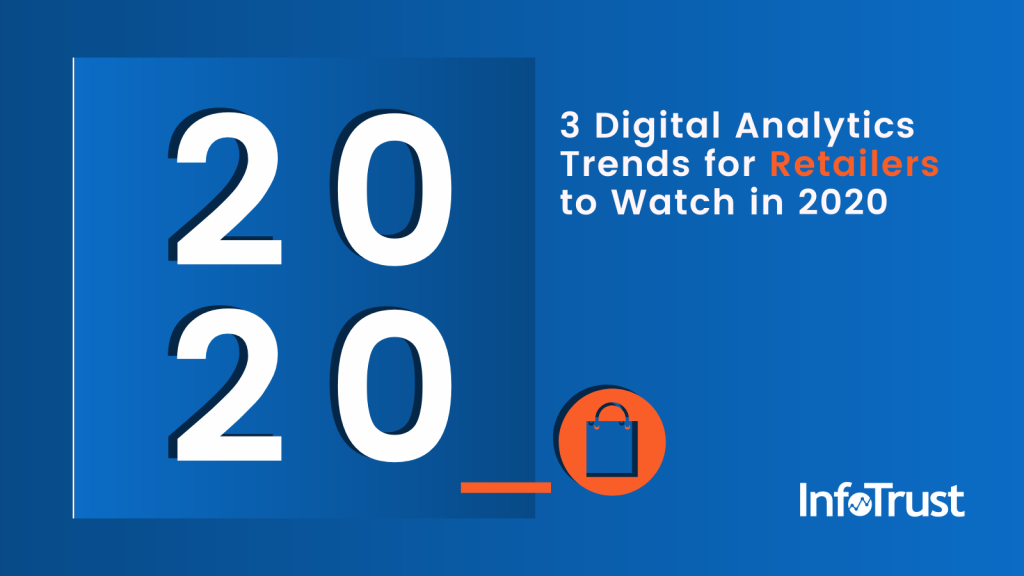“How’d they know I wanted this? How did I not know I wanted this?!”
These are the questions I ask while clicking “Buy Now” on that YETI Rambler Colster that Amazon lovingly informs me, “You may also like…” Did they know my beer was getting warm? Did they listen in as I complained about it to my wife on our back porch? Probably not, but thanks to sophisticated data collection methods, as well as real-time personalization, they understand my shopping habits and are able to suggest products I may enjoy.
Though we’re already midway through 2020’s first quarter, it’s worth taking notes of web analytics trends for online retailers that will likely define the year—and possibly beyond. Here are three such eCommerce marketing analytics trends to watch for, compiled by the InfoTrust team.
1. Business intelligence will play a more important role in how retailers connect with customers.
In order to understand your customers, you must get to know them. We can’t assume they will like a product just because we, the seller, believe it’s great. So, how do we get to know our customers?
In order to uncover these insights, we first need to gather data in such a way that 1.) gives us an accurate picture of their experience, and 2.) doesn’t violate their privacy.
Ensuring our technical house is in order is step one on the road to understanding our customers. When is the last time your organization took an end-to-end look at your data collection methods?
A few questions to get your team moving in the right direction:
- How are we utilizing custom dimensions and custom metrics?
- Does our data layer feed accurate, current data into our analytics platform?
- Is our data organized and easily accessible for those who need/use it?
- How are we utilizing integrations (such as BigQuery, CRMs, etc.)?
- How are we utilizing enhanced eCommerce?
Once we ensure all our analytics pipes are properly connected, it’s time to move to understanding this data. Dashboards and data visualization allow us to display data in a way that is simple and actionable. We have access to so much data, but need a way to cut through the noise and extract what is meaningful. Only then will we be ready to use this data to further connect with our customers.
2. Optimization and real-time analysis will allow retailers to better tailor products and messaging.
Often times, patterns will begin to emerge as we analyze our data. A certain user may browse products with a common thread through them. Or a certain product may increase in sales on a certain day of the week. Understanding these patterns will allow online retailers to craft a personalized message to customers. We can begin to recommend products buyers would truly be interested in—and do so in real-time.
Beyond product recommendations, we’re able to optimize advertising budgets for maximum return. With the data we’re capturing, we can use predictive analysis to understand the adjustments needed to yield positive results for our business. This is especially significant for retailers running sales in peak seasons. Real-time analysis will allow teams to pivot their strategy in the moment, as opposed to waiting until next season to make adjustments in advertising spend. Advanced analytics strategies like this are now within reach for your marketing analytics team (seriously). This level of analysis can also be used in other business cases, as well, such as predicting inventory needs or optimal pricing for a certain product.
3. Retailers will begin to actually bridge the gap between online and offline (O2O).
Online shopping only recently overtook brick and mortar shopping in percentage of sales. While sales are certainly taking place online, though, shoppers haven’t ditched physical stores. For digital analysts, this means finding ways to bridge the gap between the two.
Let’s say a customer first engages with your product online. They may interact with an ad or perform a search based on a recommendation from a friend. Upon seeing your product, they may decide it’s worth buying—but only after they see it in person. Using unique identifiers, such as a customer ID from your CRM, will allow you to uncover your customer’s path-to-purchase and attribute in-store purchases to online brand engagement.
Cosmetics brand Estée Lauder has worked to tie together online and offline actions by allowing customers to book in-store appointments on their website. By understanding how their customers interact with their products in-store, they are able to connect with them in the digital space in more meaningful ways.
Fortunately, the technology for this type of analysis is available and affordable. Tools like Google Ads’ store visit conversions deliver insight into which of your ads are driving traffic to your physical store. Connecting your CRM data with your analytics platform allows marketers to re-engage with customers after an in-store purchase, or build audiences around customers who return a product for a refund.
Take Your Retail Marketing Analytics to New Heights in 2020
With the right tools in the right hands, retail marketers can craft a data-centric strategy unlike ever before. Ensure your retail organization is on the cutting edge of digital marketing analytics by reaching out to the experienced team at InfoTrust. With an entire team of experienced analytics consultants dedicated to serving some of the world’s best-known retail brands, we can help you better understand your customers, the effectiveness of your marketing spend, and opportunities for growing within your business in 2020.











